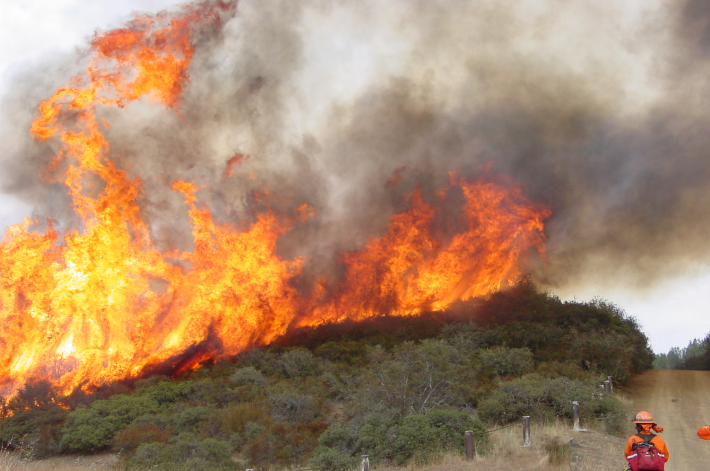Scientists study the effects of wildfire management on California avian populations
University of Arizona press release
On the tail of California’s most destructive and expensive year of firefighting ever, it might seem obvious that vegetation removal would reduce the risk of such a year happening again.
But scientists from the University of Arizona and the University of California, Berkeley, are showing that in chaparral, California’s iconic shrubland ecosystem, management can devastate wild bird populations and that fire-risk reduction is only temporary.

“We studied bird populations following two types of vegetation removal, prescribed fire and mastication (the mechanical crushing of vegetation), because both management methods have been used to try reduce wildfire risk in California chaparral,” says Erica Newman, lead author of the study and scientist in the UA School of Natural Resources and the Environment.
“We know from multiple studies that any management eventually increases fire risk as invasive grasses move in,” says Newman. “But to add to this, we now know that mastication in particular is extremely harmful to bird populations.”
This study appears in the February issue of Journal of Applied Ecology, available online today.
Chaparral is a fire-prone ecosystem in North America that is widespread throughout California. Although it makes up only six percent of California by area, it contains one-quarter of the species found in the California Floristic Province, a global biodiversity hotspot. To date, no other studies have compared the effects of different fire management types on California chaparral wildlife.
Using 24 five-acre plots in northern California, researchers reduced vegetation by 95 percent with either prescribed fire or mastication in three different seasons (winter, fall and spring).
They then tracked bird populations in each experimental and control plot using point-count surveys, in which researchers look and listen for birds for a set amount of time. Co-authors Jen Potts and Charles Vaughn visited the plots hundreds of times over the course of five years. They counted 49 species and roughly 2,500 birds.
Although bird species diversity and abundances rebounded after one-time use of prescribed fires, most birds never returned to masticated sites. Mastication reduced the number of bird species by about 50 percent and reduced total numbers of birds by about 60 percent.
“The pressures on this ecosystem’s biodiversity are intense,” says Michael L. Mann, assistant professor of geography at George Washington University, who was not part of this study. “There are over five million housing units in this ecosystem that need some form of fire protection, and wildfire risk and housing demand are only expected to increase in the next 50 years.”
Much of California’s chaparral is burning too frequently to replace itself because of human-caused ignitions and longer wildfire seasons due to climate change.
According to Scott Stephens, the principal investigator of the experiment at UC Berkeley, too-frequent fire can cause chaparral to be replaced by invasive grasses, which can increase fire risk.
This leads to other problems. Grasses don’t hold soils in place, so deadly mudslides may follow wildfires, like those in Santa Barbara, California.
Newman stresses that previous fire policy hasn’t worked to protect people or wildlife.
“The best available science tells us that managing chaparral imperils wildlife and increases fire risk,” says Newman.
“Our study continues to build the case that we should live densely and away from chaparral.”
She says that agencies like CALFIRE, California’s Department of Forestry and Fire Protection, should abandon their practice of clearing chaparral in remote areas. “Some management practices are not informed by science. We can do better.”
“A fire policy that would make more sense is to do a better job of land management planning and try to avoid the hazardous areas for building,” says Stephens.
Read the full article (freely available for a limited time):
Newman E, Potts J, Tingley M, Vaughn C and Stephens S. Chaparral bird community responses to prescribed fire and shrub removal in three management seasons. J Appl Ecol 2018. DOI: 10.1111/1365-2664.13099
Media contact:
Erica Newman, University of Arizona, Email: newmane@email.arizona.edu
Like what we stand for?
Support our mission and help develop the next generation of ecologists by donating to the British Ecological Society.